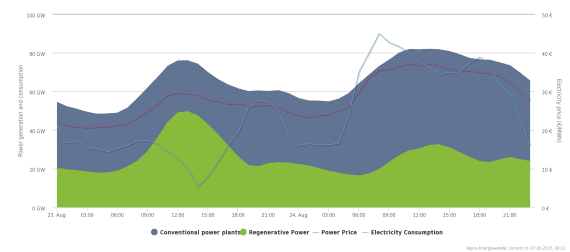The end of August brought about an encouraging event for Germany’s renewables industry, when for several hours on Sunday, August 23, some 80% of Germany’s electricity demand was met by renewable resources.
The large output of renewable energy occurred between noon and the early afternoon. Wind and solar power generation contributed most significantly to the feat. Between 12:00 and 13:00, wind provided close to 18.48 GW and solar 24.3 GW. Biomass and pumped-hydro storage also contributed moderately to the event, supplying 5.1 GW and 1.7 GW, respectively. At the same time, consumption was around 59 GW. The data were collected by Agora Energiewende.
It’s noteworthy that the daily demand was significantly lower than average — a consequence of warmer weather, it being the summer vacation period as well as the weekend, when major industrial and commercial operations are closed. Nevertheless, the news has been welcomed by the Germany renewables industry, which sees the event as evidence of the capability of renewables as a primary energy resource.
Certainly, as Germany maintains its current energy trajectory — adding more renewable capacity into its mix whilst reducing energy consumption — it is likely to see similar high-renewable-share events with greater frequency. However, it’s likely too that until major investments are made in storage techniques, Germany will remain reliant upon nuclear power (which supplied much of the remaining demand after renewables, 9.078 GW between 12:00 and 13:00) or conventional energy together with imports to meet its demands.
The event is just the latest in what’s been an exceptional summer for German renewables. July proved to be a record-breaking month, as the amount of PV and wind generated electricity fed into the grid hit an all-time high. According to Fraunhofer ISE, renewables produced 11.7 TWh in July.
During the same period, German PV generated just over the amount produced through nuclear technologies for the first time — PV power produced some 5.183 TWh, while nuclear power output was 5.181 TWh. Several nuclear plants being currently offline contributed to this record.
To place these events in some context: at the end of 2014, the share of all renewables in primary energy consumption in Germany was 11.1%. In terms of renewable generating capacity, at the end of 2014, solar held a 21.7% share; wind a 34.8% share (with 34% onshore); biomass a 30.6% share; the remainder, 12.8%, was provided by hydropower. (Data published by Federal Ministry for Economic Affairs and Energy, Germany.)
The Germany government adopted its Energy Concept, a comprehensive strategy pitched for delivering long-term development to Germany energy industries by 2050, in September 2010. The framework is working in tandem with the Energiewende, which outlines policy for incorporating an increasing amount of renewable capacity into the national energy mix.
The Energiewende includes the target that by 2020 at the latest at least 35% of German power supply is to be generated by renewable energies. Thereafter, the shares should be 50% by 2030, 65% by 2040, and 80% by 2050.
Source: CleanTechnica. Reproduced with permission.












